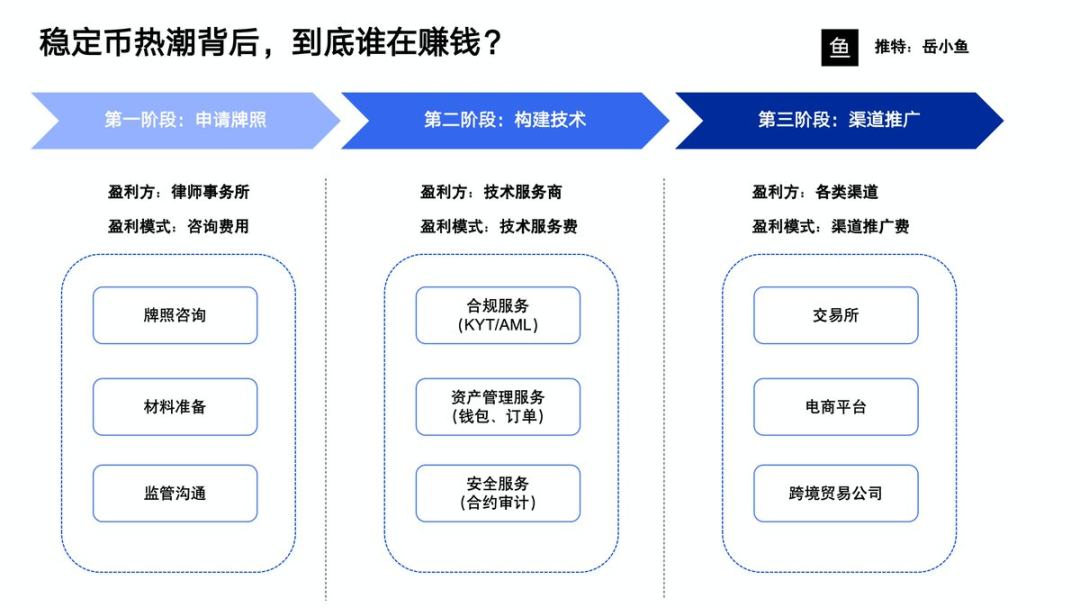Author: Yue Xiaoyu
With the compliance stablecoin leader Circle going public, it has created a benchmark effect, and domestic attention has also turned to stablecoins.
Various stablecoin payment conferences are emerging one after another, companies are organizing various learning sessions, and of course, discussions are actively happening in the crypto community, with scholars debating.
Behind the hustle and bustle, who is actually making money?
In fact, according to the overall process, the development of stablecoins can be divided into three phases, each of which has different roles that can earn money.

Phase One: Apply for a License.
Compliance comes first; currently, everyone is applying for licenses in Hong Kong.
The biggest problem with Hong Kong regulation is that it is overly strict, requiring many things, and many companies do not know how to meet regulatory requirements.
At this time, law firms will jump in first, providing legal consulting services to companies applying for licenses, helping them submit materials and communicate with regulators.
So at this stage, law firms have made money first.
Phase Two: Build Technology.
Compliance and technology can run in parallel; many companies apply for licenses while building technical systems, so once the license is approved, they can immediately launch their stablecoin and seize the opportunity.
If you wait until the license is issued before starting the project, you will miss the time window and be far too late.
Doing stablecoin payments is quite complicated; it requires compliance services, asset management services, token issuance services, liquidity management services, security services, etc.
Specific services include KYB, KYT, AML, order management, address management, clearing and settlement, capital inflow and outflow, contract auditing, on-chain security, etc.
However, traditional Web2 companies actually lack relevant experience and talent accumulation in blockchain development, so they need to cooperate with Web3 technology service companies.
Therefore, in this phase, many Crypto technology service providers also begin to attract customers and directly generate income.
Phase Three: Channel Promotion.
If you have a license and have developed the technology, you can directly start your business.
However, at present, the vast majority of companies are still in the first and second phases, with the third phase at most in the negotiation stage.
However, once business is launched, it will be a situation of 'hundred coin battles'.
For stablecoins, liquidity is key.
Various stablecoins need to find their business scenarios and expand their usage scale.
Thus, channel promotion is very important; it is essential to find substantial channels for cooperation.
A typical example is Circle; the rapid rise of USDC relies mainly on the liquidity and brand endorsement provided by Coinbase.
This is a clear development path; for Hong Kong stablecoin players, they must bind various channels to seize the market.
In this phase of the hundred coin battles, the most profitable are various channels, including exchanges, e-commerce platforms, cross-border trade companies, etc.
After going through the aforementioned three phases, only the stablecoins that emerge can truly make money.
Eventually, one stablecoin will emerge as the leader in the Hong Kong region or the Chinese-speaking region, squeezing out the space of other competitors and gaining the majority market share through the siphoning effect.
After establishing a solid market share, the next step is to increase profitability; this is when stablecoin issuers start making money.
Referencing domestic battles in ride-hailing, shared bicycles, and food delivery, they all follow such paths.
At the beginning, it is all a chaotic battle; the players that emerge at the end will take all, and after the subsidy wars, they will need to recuperate, reduce subsidies, and raise prices to become profitable.
During this time, profitability is also very daunting; stablecoin issuers themselves rely on a large volume of assets to be profitable.
In addition to various project parties, for ordinary users, a more direct benefit is that when new stablecoin forces grab market share and liquidity through subsidies, we retail investors can also profit from it.
In summary, the stablecoin craze can be said to be 'the bigger the water, the bigger the fish'; one must seize their own piece of the pie.



